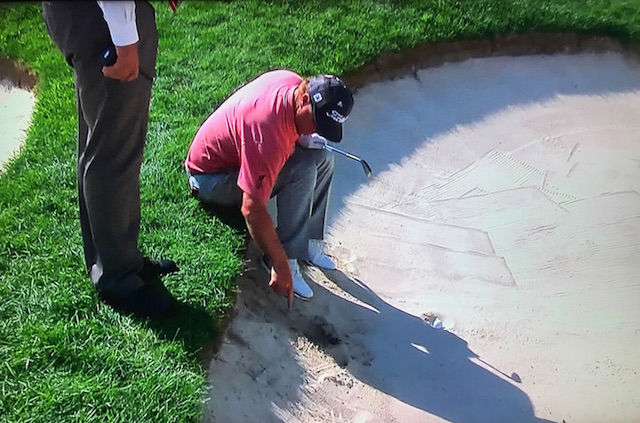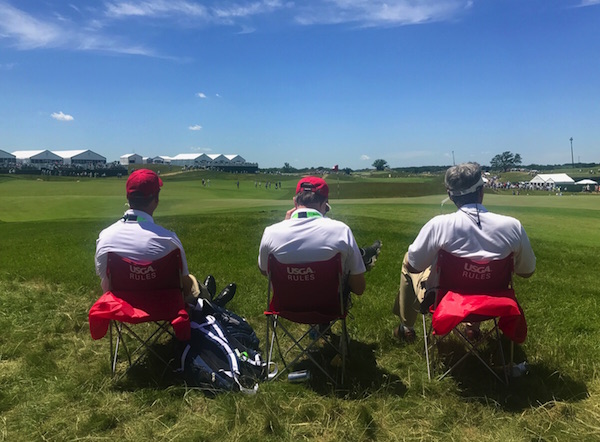Another Bunker Liner Ruling: Hoffman Gets Out Of Plugged Lie
/Here's the situation: final round, 2017 RBC Canadian Open, Charley Hoffman hits into a greenside bunker at the 12th and has a badly buried lie:

Credit Hoffman and caddie for recognizing the renovated Glen Abbey bunkers for having newly installed bunker floor lining that prevented him from digging enough to take a stance on his bunker shot. (You can see a demo at the 1:30 mark of how it is sprayed in). And even cred it them for asking to get a ruling even after Hoffman can be heard saying multiple times he did not believe there was any kind of artificial lining causing an issue (his caddie wasn't so sure and convinced him to get a second opinion). CBS's Peter Kostis said exactly the opposite: Hoffman was calling for a ruling because he could feel the liner. Maybe he had a producer yelling in his ear during the conversation, but it was still misleading.
Official Gary Young arrived and seemed very reluctant to give Hoffman relief, but the player soon could smell an opening, ultimately convincing Young that he could not take his stance because of the concrete lining.

"That's so generous!" barked out playing partner Kevin Chappell, somewhat sarcastically. Young replied that it was consistent with other rulings related to the new age bunker liners designed to keep sand on faces and from being contaminated. Chappell then lightly pointed out Hoffman's smile upon getting relief:
Getting relief from a 🍳 V dishonest. Apparently Hoffman's stance was impeded by an exposed bunker liner. https://t.co/tkc3ApxDth
— the fried egg (@the_fried_egg) July 30, 2017
One other comment from Chappell, again with a light touch, prompted a one-word response and smile from Hoffman as he went about his business: "Rules."
Given the behind-the-scenes grumbling still taking place over Branden Grace's BMW PGA relief from a buried lie while citing bunker lining as a stance preventative, it's hard to see how Hoffman's will be any better received by his peers (note the sampling of fan outrage below).
However, it should be noted that Hoffman was initially skeptical about even suggesting he deserved a drop from the lie. He went on to lose the Canadian Open in a playoff to Jhonattan Vegas.
The situation seems worse than it might appear given that the PGA Tour, which has signaled a desire to be in the news delivery business via the web and television, scrubbed videos of the drop after briefly posting them to official Facebook and Twitter accounts.
Here is the PGA Tour Facebook post of the ruling, deleted (thanks reader Jeremy S).
And the Tweet captured by reader MS:
Hey @GeoffShac did you get to see this tweet from @PGATOUR before they deleted it? pic.twitter.com/SNkNj8IXSE
— CommonSpence (@GetSocialAdept) July 30, 2017
The reaction below sums up the social media reaction, which offers another reminder that it's very hard to bend the rules and not go unnoticed in the age of social media:
Charlie Hoffman should just wear these next time he gets a bad lie in a bunker and wants to dig to the base layer in search of a drop. pic.twitter.com/IZDHrxJQYv
— Eamon Lynch (@eamonlynch) July 30, 2017
@hoffman_charley disgraceful drop you should be ashamed @PGATOUR
— Richard Piggott (@richpigg1) July 30, 2017
I was just gonna say, literally as soon as he's finished getting that ruling Hoffman is laughing his head off. No way he should get a drop
— George Adey (@george_adey) July 30, 2017
@hoffman_charley showing if you dig deep enough you can get a free drop from a bad lie. Game of integrity slipping. 😩😩
— Fight On (@rickoharrison) July 30, 2017
@GolfChannel Hoffman's drop on 12 was atrocious! No rules for politicians and PGA golfers.
— Sparse Hackle (@SparseHackle) July 30, 2017
@mcginleygolf Whatever happened to 'Play the Ball as it lies & Play the course as you find it'??
— Frank Hanna (@SERGIO_FELLA81) July 30, 2017
Re: Hoffman drop in bunker.. pampered pros
What do we learn from this?
A) Bunker liners are going to be an ongoing problem. A product meant to keep sand from becoming contaminated and to keep sand on bunker faces is now being used to subvert the game's original rule: play it as it lies.
B) Players are increasingly unafraid to stretch the boundaries of the rules to gain an advantage.
C) Instead of embracing this as a learning situation, the PGA Tour scrubbed their accounts of the evidence, which will only make Hoffman's peers and their caddies wonder what needed hiding. Even though Hoffman was initially skeptical that the situation warranted a ruling, much less a drop, the lack of transparency will raise suspicions about what went down.























